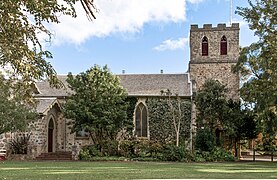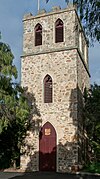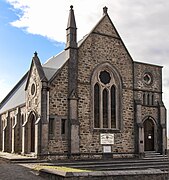world.wikisort.org - Australia
Albany (/ˈælbəni/ AL-bən-ee; Nyungar: Kinjarling) is a port city in the Great Southern region in the Australian state of Western Australia, 418 kilometres (260 mi) southeast of Perth, the state capital. The city centre is at the northern edge of Princess Royal Harbour, which is a part of King George Sound. The central business district is bounded by Mount Clarence to the east and Mount Melville to the west. The city is in the local government area of the City of Albany. While it is the oldest colonial, although not European,[lower-alpha 1] settlement in the territory that today is Western Australia,[lower-alpha 2] predating Perth and Fremantle by over two years, it was a semi-exclave of New South Wales for over four years until it was made part of the Swan River Colony.
| Albany Kinjarling Western Australia | |||||||||
|---|---|---|---|---|---|---|---|---|---|
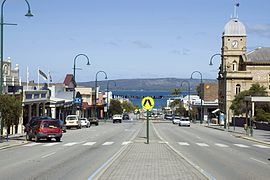 York Street in Albany | |||||||||
 Albany | |||||||||
| Coordinates | 35°01′22″S 117°52′53″E | ||||||||
| Population | 29,373 (UCL 2016)[1] | ||||||||
| Established | 26 December 1826 | ||||||||
| Postcode(s) | 6330 | ||||||||
| Area | 297.2 km2 (114.7 sq mi)[2] (2011 urban) | ||||||||
| Time zone | AWST (UTC+8) | ||||||||
| Location | |||||||||
| LGA(s) | City of Albany | ||||||||
| State electorate(s) | Albany | ||||||||
| Federal division(s) | O'Connor | ||||||||
| |||||||||





The settlement was founded on 26 December 1826 as a military outpost of New South Wales for the purpose of forestalling French ambitions in the region.[3]: 61 To that end, on 21 January 1827, the commander of the outpost, Major Edmund Lockyer, formally took possession for the British Crown of the portion of New Holland not yet claimed by the British Crown;[lower-alpha 3] that is, the portion west of 129th meridian east, with the portion east already being claimed collectively by the British Crown as New South Wales and Van Diemen's Land.[4] During the last decade of the 19th century the town served as a gateway to the Eastern Goldfields. For many years, it was the colony's only deep-water port, having a place of eminence on shipping services between Britain and its Australian colonies. The opening of the Fremantle Inner Harbour in 1897,[5]: 51–55 however, saw its importance as a port decline, after which the town's industries turned primarily to agriculture, timber and later, whaling.
Contemporary Albany is the southern terminus for tourism in the region, and the state's south west,[6] which is known for its natural environment and preservation of its heritage. The town has a role in the ANZAC legend, being the last port of call for troopships departing Australia in the First World War. On 1 November 2014, the Australian and New Zealand Prime Ministers opened the National Anzac Centre in Mount Clarence, Albany, to commemorate 100 years since the first ANZAC troops departed from King George Sound. Approximately 40,000 people attended the commemoration events held between 30 October and 2 November 2014.[7]
An auxiliary submarine base for the US Navy's 7th Fleet was developed during the Second World War in the event the submarine base at Fremantle was lost. Also in the harbour was a Royal Australian Navy naval installation which provided for refuelling from four 5,100-tonne (5,000-long-ton) fuel tanks.[8]: 26
Etymology
Upon its establishment in 1826, the settlement was named Frederick Town in honour of Prince Frederick, Duke of York and Albany.[9][10][11] In 1831, the settlement was transferred to the control of the Swan River Colony and renamed Albany by Lieutenant-Governor James Stirling.[12]: 55–115
The name of the area in the Nyungar language of the Menang people is Kinjarling, which has been said to mean "place of plenty" and "place of rain".[13][14] In 2020, the City of Albany began, as part of an official dual-naming project, to give prominence to “Kinjarling” as the city's Aboriginal name.[13]
Early history
Kinjarling was home to Menang Noongar tribes during the summer season.[15] Early British explorers recorded evidence of fish traps located on Emu Point and on the French, now the Kalgan, River. Vancouver made attempts to find the inhabitants of the area but only found bark dwellings that were unoccupied. Later explorers made contact and were told to leave, but were accepted when they did not. Most of the British exploration was undertaken to survey the land and sea to assess the profitability of resources. The explorers occasionally noted encounters with Noongars. Native treatment laws and programs have affected the tribes since settlement.
Heritage buildings
There are a number of heritage buildings in Albany; see List of heritage places in the City of Albany and Category:Heritage places in Albany, Western Australia. These include:
- The Old Farm, Strawberry Hill was established in 1827 as a government farm to feed the colonial soldiers stationed around King George's Sound. It is the oldest farm in Western Australia. The homestead, which became the home of the Government Resident in 1833, is an example of a colonial gentleman's residence. After a chequered history, the property was vested in the National Trust WA in 1964 and is now a house museum.
- Patrick Taylor Cottage (1832), Western Australia's oldest surviving dwelling, built in 1832 by the Morley Brothers. It is now maintained by the Albany Historical Society.
- St John's Church (1841–1848) is a stone building with shingled roofs in the Old Colonial Gothick Picturesque style. Set among trees, it was designed to be part of an overall contrived picturesque scene in the manner of an English garden landscape.[16]
- Scots Uniting Church (1892) was designed in the Victorian Academic Gothic style by Melbourne architect Evander McIver and built with local granite stonework.
- The complex now known as The Residency Museum was established in 1850 as a depot for the Convict Establishment in Albany. It is an L shaped, single-storied, masonry building with a timber framed, timber shingled roof. In 1873 it was converted into the Resident Magistrate's home. It now serves as a museum.
- The Victorian Free Classical Revival style Town Hall (1888) is a two-storey stone building with a prominent clock tower, which dominates York Street, the main street of Albany. It has been put to many uses apart from council meetings, including public entertainment and public meetings of all kinds and even as the venue for the first regional meeting of the State Parliament.
- The Old Post Office was built in two stages, the first was designed in 1869 by J Manning, the second, including a prominent tower, was designed in 1896 by George Temple-Poole. It now houses the Albany campus of the University of Western Australia.
- The Court House, constructed of Albany brick and granite with a tiled roof, was designed in the Federation Romanesque style by the Public Works Department under the supervision of George Temple-Poole and Hillson Beasley in 1897.
- Another example of the work of George Temple Poole is the limestone and shingle Federation Arts and Crafts style Cottage Hospital, designed in 1886 and completed in 1897. It is one of the oldest hospitals in the state and served as such until 1962. It is now occupied by the Vancouver Arts Centre (named after the explorer George Vancouver).
- Images of heritage buildings
- Old Farm, Strawberry Hill
- Old Farm, drawing room
- St. John's Church
- St.John's Church tower
- Albany Courthouse
- Old Post Office, north front
- Old Post Office, south front
- Scots Uniting Church
- Vancouver House, formerly the Cottage Hospital
- Town Hall, Albany
- Patrick Taylor Cottage, Duke Street
Some of the above information is derived from the State Heritage Register[17] where these places are registered. The assessment criteria contain more details.
Population
In June 2018, the urban population of Albany was 34,205[18] making it the state's sixth-largest population centre.[19]
- Aboriginal and Torres Strait Islander people made up 3.5% of the population.
- 74.3% of people were born in Australia. The next most common countries of birth were United Kingdom 7.5%, New Zealand 1.7%, Philippines 1.6%, and South Africa 1.1%.
- 86.8% of people only spoke English at home. Other languages spoken at home included Filipino 0.7%, Italian 0.6%, Tagalog 0.6%, Afrikaans 0.6% and German 0.4%.
- The most common religious denominations were Anglican 16.5% and Catholic 13.1%. 37.4% had no religion and 10.4% did not respond.[20]
Geography

The city centre of Albany is located between the hills of Mount Melville and Mount Clarence, which look down into Princess Royal Harbour. Many beaches surround Albany, with Middleton Beach being the closest to the town centre. Other popular beaches include Frenchman Bay and Muttonbird Island.
Albany is 418 km (260 mi) SSE of the state capital, Perth, to which it is linked by Albany Highway.
Wine region
Albany is a sub-region of the Great Southern region of Western Australia.[21]
Coastline
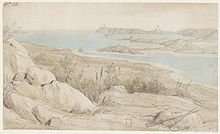


The Albany coastline is notorious for deaths due to king waves washing people off rocks. The Torndirrup National Park features some of the more rugged coastline in the area. However, there are many beaches that are safe and usable.
Betty's Beach was named after Betty Jones, who used to go camping there with her family, and was initially called Betty's Bay.[22]
Frenchman Bay Beach is adjacent to the Torndirrup National Park, and was originally called Quarantine Bay, owing to the quarantine station set up by the British in 1826 on Mistaken Island at the northern end of Goode Beach[23]
Misery Beach, located 20 km (12 mi) south of Albany, was so named owing to the location of the whaling station at Albany that operated until 1978, causing offal to be washed ashore at Misery Beach and its sand and waters to be stained red. However, the beach was named Tourism Australia Best Beach 2022 by Tourism Australia, described a "[ticking] all the boxes of what the typical beachgoer is looking for — uncrowded, crystal-white sand, turquoise waters and a very dramatic granite backdrop".[24]
Other beaches include:
- Emu Point
- Gull Rock Beach, also known as Boiler Beach
- Middleton Beach
- Nanarup Beach
- Muttonbird Beach
- Cosy Corner
- Two Peoples Bay, including Little Beach and Waterfall Beach
Climate
Albany has a warm-summer Mediterranean climate (Köppen Csb) with dry, warm summers, mild, wet winters, and pleasant springs and autumns.[25]: 5 Summers have short spells of very hot weather, but cool ocean breeze brings relief, especially during evenings and nights. The city is situated on what is promoted as the "Rainbow Coast", an appropriate title given the frequency of days with both sun and drizzle or showers. Albany has 44.8 clear days annually.
July is the wettest month, with a long-term average of 144.0 mm (5.67 in). Rain in excess of 0.2 mm (0.01 in) occurs on two days out of every three during an average winter. The driest month is February with a mean of 22.9 mm (0.90 in).
Albany received a record amount of rain on 20 November 2008 when violent storms swept across the Great Southern region. The town was flooded after 113.8 mm (4.48 in) of rain fell in a 24-hour period, the highest amount recorded since rainfall records began in 1877.[26] The wettest month on record was June 1920 when 292.8 mm (11.5 in) fell, while February 1877 and February 1879 remain the only rainless months.
| Climate data for Albany Airport | |||||||||||||
|---|---|---|---|---|---|---|---|---|---|---|---|---|---|
| Month | Jan | Feb | Mar | Apr | May | Jun | Jul | Aug | Sep | Oct | Nov | Dec | Year |
| Record high °C (°F) | 45.6 (114.1) |
44.2 (111.6) |
41.2 (106.2) |
38.8 (101.8) |
32.6 (90.7) |
24.8 (76.6) |
22.5 (72.5) |
26.2 (79.2) |
27.9 (82.2) |
33.6 (92.5) |
39.2 (102.6) |
42.8 (109.0) |
45.6 (114.1) |
| Average high °C (°F) | 24.8 (76.6) |
24.9 (76.8) |
24.1 (75.4) |
21.9 (71.4) |
19.0 (66.2) |
16.7 (62.1) |
15.8 (60.4) |
16.2 (61.2) |
17.3 (63.1) |
18.8 (65.8) |
20.9 (69.6) |
23.1 (73.6) |
20.3 (68.5) |
| Average low °C (°F) | 13.7 (56.7) |
14.5 (58.1) |
13.4 (56.1) |
11.7 (53.1) |
9.8 (49.6) |
8.1 (46.6) |
7.5 (45.5) |
7.5 (45.5) |
8.1 (46.6) |
9.2 (48.6) |
10.8 (51.4) |
12.5 (54.5) |
10.6 (51.1) |
| Record low °C (°F) | 4.8 (40.6) |
5.1 (41.2) |
4.3 (39.7) |
3.2 (37.8) |
1.9 (35.4) |
0.0 (32.0) |
−0.2 (31.6) |
0.8 (33.4) |
0.7 (33.3) |
1.0 (33.8) |
2.7 (36.9) |
3.6 (38.5) |
−0.2 (31.6) |
| Average precipitation mm (inches) | 23.6 (0.93) |
22.3 (0.88) |
33.6 (1.32) |
61.3 (2.41) |
89.8 (3.54) |
108.0 (4.25) |
119.3 (4.70) |
106.8 (4.20) |
88.5 (3.48) |
70.8 (2.79) |
47.0 (1.85) |
27.8 (1.09) |
798.1 (31.42) |
| Average precipitation days (≥ 1mm) | 2.8 | 2.6 | 4.0 | 6.3 | 8.2 | 9.9 | 11.1 | 10.9 | 9.9 | 8.0 | 5.7 | 3.7 | 83.1 |
| Average relative humidity (%) | 69 | 69 | 71 | 76 | 78 | 79 | 79 | 77 | 75 | 75 | 73 | 70 | 74 |
| Average dew point °C (°F) | 13 (55) |
13 (55) |
12 (54) |
12 (54) |
10 (50) |
8 (46) |
8 (46) |
8 (46) |
8 (46) |
10 (50) |
11 (52) |
12 (54) |
10 (51) |
| Mean monthly sunshine hours | 251.1 | 209.1 | 204.6 | 186.0 | 167.4 | 153.0 | 170.5 | 189.1 | 189.0 | 210.8 | 222.0 | 244.9 | 2,397.5 |
| Source 1: Bureau of Meteorology[27] | |||||||||||||
| Source 2: Time and Date (humidity and dew point)[28] | |||||||||||||
Industry



Albany's main industries are tourism, fishing, timber (wood chips) and agriculture. From 1952 to 1978 whaling was a major source of income and employment for the local population.
The Whaling Station, which closed operations in 1978, has been converted to a museum of whaling and features one of the 'Cheynes' whale chasers that were used for whaling in Albany. The station was the last operating whaling station in the southern hemisphere and the English-speaking world at the time of closure.[29]
The Western Power Wind Farm is located at Sand Patch, to the west of Albany. The wind farm, originally commissioned in 2001 with 12 turbines, now has 18 turbines, driven by strong southerly winds, and can generate up to 80%[30] of the city's electricity usage.[31]
Albany has a number of historical sites including the Museum, Albany Convict Gaol, The Princess Royal Fortress (commonly known as The Forts) and Patrick Taylor Cottage, one of the oldest dwellings in Western Australia, c. 1832.[32] Albany has a great deal of historical significance to Western Australia.
Natural sights along the rugged coastline include the 'Natural Bridge' and the 'Gap'. The beaches have pristine white sand. The destroyer HMAS Perth was sunk in King George Sound in 2001 as a dive wreck.[33] Albany is also close to two low mountain ranges, the Porongurups and Stirling Ranges.
Albany is the southern terminus of the Bibbulmun Track walking trail.[34]
Albany is the southern terminus of the Munda Biddi Trail off-road cycling trail.[35]
Albany is home to HMAS Albany (based in Darwin) and the adopted home port of the Royal Australian Navy frigate HMAS Anzac. Albany is frequently visited by other warships.
Transport
Albany has a city bus service run by Swan Transit with five town routes. Albany is connected to Perth with road-coach services via Walpole and Bunbury; via Katanning and Northam; via Kojonup and Williams. Transwa coaches also serve Jerramungup, Ravensthorpe and Hopetoun.[36]
Regional Express Airlines, a national independent regional airline, provides 23 services a week between Perth and Albany Airport using 34-passenger turboprop Saab 340 aircraft.[37][38]
Albany was served by the Albany Progress passenger train from Perth until 1978. The railway station reopened as a tourist information centre in 1994.[39]
Media
Albany radio stations include 783 Triple M (formerly 6VA and RadioWest), GOLD MX, Rete Italia, Vision FM, Fly FM Albany, HitFM (formerly HOT FM), ABC South Coast, ABC News, ABC Radio National, ABC Classic FM, Triple J, Racing Radio & Great Southern FM.
Below is a table showing the broadcast frequencies on which these services can be received.
| Service | Broadcast frequency |
|---|---|
| ABC Local Radio | 630 kHz AM |
| 783 Triple M | 783 kHz AM |
| GOLD MX | 1611 kHz AM |
| Rete Italia | 1629 kHz AM |
| Vision FM (Local) | 87.6 MHz FM |
| Fly FM | 88.0 MHz FM |
| ABC News | 92.1 MHz FM |
| Triple J | 92.9 MHz FM |
| Vision FM | 93.7 MHz FM |
| ABC Classic FM | 94.5 MHz FM |
| HitFM | 95.3 MHz FM |
| ABC Radio National | 96.9 MHz FM |
| Great Southern FM | 100.9 MHz FM |
| Racing Radio | 104.9 MHz FM |
| HitFM (Local) | 106.5 MHz FM |
Localised television stations available in Albany include GWN7, WIN Television Western Australia, West Digital Television, SBS and ABC Television Western Australia. GWN7 broadcasts a half-hour news program for regional WA, GWN7 News, at 5:30pm on weeknights with a district newsroom covering Albany and surrounding areas based in the city.
Below is a table showing the full suite of digital television services available in Albany. These services are broadcast from Mount Clarence and cover the majority of the geographic area with some areas requiring a signal to be received from the Southern Agricultural site at Mount Barker. Both these transmission sites employ vertical polarity. Furthermore, a number of residents rely on receiving these services via satellite using the Viewer Access Satellite Television system.
| LCN | Channel name | Broadcast ch. no. | Broadcast frequency |
|---|---|---|---|
| 2 | ABC TV | UHF 43 | 634.5 MHz |
| 3 | SBS TV | UHF 41 | 620.625 MHz |
| 5 | 10 HD | UHF 44 | 641.5 MHz |
| 6 | GWN7 | UHF 45 | 648.5 MHz |
| 8 | Channel 9 | UHF 42 | 627.5 MHz |
| 20 | ABC HD | UHF 43 | 634.5 MHz |
| 21 | ABC TV | UHF 43 | 634.5 MHz |
| 22 | ABC TV Plus/KIDS | UHF 43 | 634.5 MHz |
| 23 | ABC ME | UHF 43 | 634.5 MHz |
| 24 | ABC NEWS | UHF 43 | 634.5 MHz |
| 30 | SBS HD | UHF 41 | 620.625 MHz |
| 31 | SBS VICELAND | UHF 41 | 620.625 MHz |
| 32 | SBS WORLD MOVIES | UHF 41 | 620.625 MHz |
| 33 | SBS FOOD | UHF 41 | 620.625 MHz |
| 34 | NITV | UHF 41 | 620.625 MHz |
| 50 | 10 BOLD | UHF 44 | 641.5 MHz |
| 55 | 10 Peach | UHF 44 | 641.5 MHz |
| 62 | 7TWO | UHF 45 | 648.5 MHz |
| 63 | 7mate | UHF 45 | 648.5 MHz |
| 65 | ishop TV | UHF 45 | 648.5 MHz |
| 68 | RACING.COM | UHF 45 | 648.5 MHz |
| 80 | 9HD | UHF 42 | 627.5 MHz |
| 82 | 9Gem | UHF 42 | 627.5 MHz |
| 83 | 9Go! | UHF 42 | 627.5 MHz |
| 84 | TVSN | UHF 42 | 627.5 MHz |
| 85 | 9Life | UHF 42 | 627.5 MHz |
Local newspapers are the Albany Advertiser (established 1888) and The Extra (owned by Seven West Media Limited, publishers of The West Australian), and The Great Southern Weekender (independently owned by Beaconwood Holdings Pty Ltd). The Great Southern Weekender also owns local radio stations GOLD MX and Fly FM.
Sport
Two of Albany's major sports facilities are Collingwood Park Stadium in Collingwood Park and Centennial Oval in Centennial Park.[40] Collingwood Park is home to North Albany Football Club[40] while Centennial Oval is home to Royals Football Club.[41]
Albany Leisure and Aquatic Centre is the home of Albany Basketball Association.[42] The Rainbow Coast Raiders of the State Basketball League played at the Albany Sports Centre (33 Barker Road) between 1989 and 1999.[43] 33 Barker Road is now the home of Albany Indoor Beach Volleyball.[44]
Education
There are currently several primary schools, eight high schools and one university campus in the Albany area.
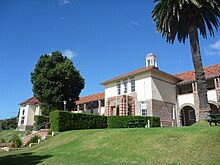


Primary schools
- Albany Primary School
- Flinders Park Primary
- Mount Lockyer Primary
- Parklands School
- Spencer Park Primary
- Yakamia Primary
- Woodbury Boston Primary School
- OneSchool Global (Albany)
- Little Grove Primary School
- St Joseph's College
- Great Southern Grammar
- Bethel Christian School
- Australian Christian College Southlands
- John Calvin School
High schools
- Albany Senior High School 7–12
- Albany Secondary Education Support Centre 7–13
- Australian Christian College - Southlands K-12
- North Albany Senior High School 7–12
- Great Southern Grammar K-12
- St Joseph's College K-12
- Bethel Christian School K-12
- John Calvin School K-10
Universities
- A campus of the University of Western Australia
- Some courses delivered by Curtin University
TAFE
- South Regional TAFE
Localities
Notable residents
See also
- Albany Regional Prison
- City of Albany
- Electoral district of Albany
- Port of Albany
Notes
- The Wiebbe Hayes Stone Fort on West Wallabi Island is the oldest surviving European building in Australia.[lower-alpha 4]: 37 It was built by survivors of the Batavia shipwreck and massacre in 1629, predating Frederick Town by 197 years and indeed James Cook's first visit to Australia by 141 years. Frederick Town became Albany in 1831 upon becoming a part of the Swan River Colony.
- Frederick Town became a part of the Swan River Colony in 1831, in contrast to Perth which was founded on 12 August 1829 as the administrative centre of the Swan River Colony. The Swan River Colony became the Colony of Western Australia on 6 February 1832, which in turn became the state of Western Australia upon federation on 1 January 1901.
- Every one of these claims by the British Crown was in competition to claims, possession and occupancy by Aboriginal and Torres Strait Islander peoples that predate the claims by the British Crown by tens of millennia.
- Michael Pearson (2005). Margaret Cresswell (ed.). Great Southern Land: The Maritime Exploration of Terra Australis (PDF). Canberra: Department of the Environment and Heritage. ISBN 0-642-55185-5. OCLC 67617194. OL 26818732M. Wikidata Q110529184. Retrieved 12 January 2022.
References
- Australian Bureau of Statistics (27 June 2017). "Albany (Urban Centre and Locality)". Australian Census 2016.
- "2011 Census Community Profiles: Albany". ABS Census. Australian Bureau of Statistics. Retrieved 15 September 2016.
- Battye, James Sykes (2005) [First published 1924]. Western Australia: A History from its Discovery to the Inauguration of the Commonwealth. Oxford: Clarendon Press. OCLC 4362013. Retrieved 24 September 2021 – via Project Gutenberg of Australia.
- "King George's Sound Settlement". State Records. State Records Authority of New South Wales. Archived from the original on 24 June 2014. Retrieved 23 September 2021.
- Hutchison, David (2006). Fremantle Walks. Fremantle: Fremantle Arts Centre Press. ISBN 1921064307. OCLC 86110696.
- "Destination Albany". Retrieved 7 October 2017.
- "Anzac Albany | National Anzac Centre". www.nationalanzaccentre.com.au. Retrieved 15 February 2020.
- Commander Seventh Fleet (15 September 1944). Base Facilities Report (Report). United States Navy. Retrieved 26 September 2021.
- Nind, Isaac Scott (7 February 1828). "View of Frederick Town, King Georges Sound, at the expiration of the first year of its settlement" (pdf). Manuscripts, Oral History and Pictures. State Library of New South Wales. Retrieved 12 May 2014.
- Nind, Isaac Scott (1832). "Description of the Natives of King George's Sound (Swan River Colony) and Adjoining Country". The Journal of the Royal Geographical Society of London. 1: 21–51. doi:10.2307/1797657. JSTOR 1797657. Retrieved 12 May 2014.
- Wilson, Thomas Braidwood (1835). "Formation of the Settlement at King George's Sound". Narrative of a Voyage Round the World. London: Sherwood Gilbert & Piper. p. 281. Retrieved 12 May 2014.
- West, Dunstan Arthur Percival (2004) [1976]. The Settlement on the Sound – Discovery and settlement of the Albany Region 1791–1831. Perth: Western Australian Museum. OCLC 4466596.
- Dobson, John (3 July 2020). "Albany, WA's oldest colonial settlement, to officially adopt joint Noongar names". ABC Great Southern. Retrieved 4 July 2020.
- Goode, Brad (2013). Council Report 'Kinjarling' The Place of Rain:The City of Albany & Department of Indigenous Affairs Aboriginal Heritage Survey. Albany, WA: City of Albany. Retrieved 4 July 2020.
- "Albany History Gallery: Albany History Gallery & Meaning of Town Names ending in UP". Kalgan Queen Riverboat, Cruise Tour and Albany Horse-drawn wagon tours. Archived from the original on 24 January 2010. Retrieved 25 September 2021.
- "Strawberry Hill". National Trust. Canberra, ACT: Australian Council of National Trusts. Retrieved 23 May 2018.
- "State Heritage Register". Heritage Council, State Heritage Office. Retrieved 1 November 2015.
- "3218.0 – Regional Population Growth, Australia, 2017-18: Population Estimates by Significant Urban Area, 2008 to 2018". Australian Bureau of Statistics. Australian Bureau of Statistics. 27 March 2019. Retrieved 22 April 2019. Estimated resident population, 30 June 2018.
- "About Albany". City of Albany. 4 February 2016. Archived from the original on 29 February 2016. Retrieved 26 September 2021.
- Australian Bureau of Statistics (27 June 2017). "Albany (Significant Urban Area)". 2016 Census QuickStats. Retrieved 5 January 2018.
- James Halliday (2009). The Australian Wine Encyclopedia. Hardie Grant Books. ISBN 978-1-74066-774-6.
- "Bettys beach secluded & fun near Albany". Albany Tours. Retrieved 31 January 2022.
- "Albany, Western Australia". Frenchman Bay Association (FBA). Retrieved 31 January 2022.
- Edwards, Tom (29 January 2022). "Misery Beach, on Western Australia's south coast, named Tourism Australia Best Beach 2022". ABC News. Australian Broadcasting Corporation. Retrieved 31 January 2022.
- Garden, Donald S. (1977). Albany: a panorama of the Sound from 1827. West Melbourne, Victoria: Thomas Nelson (Australia). ISBN 0-17-005167-6. OCLC 4191823.
- "PerthNow - Storm dumps record rainfall on Albany". 20 November 2008. Archived from the original on 3 September 2012. Retrieved 24 November 2008.
- "Climate Statistics for Albany Airport Comparison". Climate statistics for Australian locations. Bureau of Meteorology. Retrieved 23 April 2016.
- "Climate & Weather Averages in Albany, Western Australia, Australia". Time and Date. Retrieved 9 January 2021.
- "Whaling". State Library of Western Australia. Retrieved 3 May 2017.
- "Albany Wind Farm". Verve Energy. 2013. Archived from the original on 22 November 2013. Retrieved 7 October 2013.
- Wind Energy in Western Australia Archived 9 March 2008 at the Wayback Machine Jade Carlton, www.sustainability.dpc.wa.gov.au. Retrieved 3 August 2007.
- "Assessment Documentation - Patrick Taylor Cottage". Register of Heritage Places. Heritage Council of Western Australia. 30 June 2009. Archived from the original (pdf) on 12 May 2014. Retrieved 12 May 2014.
- Former HMAS Perth Dive Wreck Archived 18 June 2013 at the Wayback Machine www.albany.wa.gov.au. Retrieved 3 August 2007.
- "Albany Bibbulmun Track". Bibbulmun Track Foundation. Retrieved 7 October 2017.
- "Exploring Munda Biddi – the world's longest continuous bike trail". RideOn. 9 December 2013. Retrieved 10 October 2018.
- Timetable Files Archived 2 September 2016 at the Wayback Machine Transwa
- "REX airline to fly to Albany and Esperance". The West Australian. Perth, WA. 22 February 2016. Archived from the original on 10 June 2016. Retrieved 21 May 2016.
- Start of Rex flights welcomed Minister for Agriculture & Food Transport 27 February 2016
- "Visitor Centre". City of Albany. Archived from the original on 5 April 2016. Retrieved 25 September 2021.
- "Major boost to an Albany sports facility". triplem.com.au. 18 January 2017. Retrieved 24 October 2021.
- "History". Royals Football Club. Retrieved 24 October 2021.
- Newbold, Cameron (14 March 2017). "Raiders claim successful under-16 girls tournament". albanyadvertiser.com.au. Retrieved 24 October 2021.
- "Rainbow Coast Raiders" (PDF). SBL.asn.au. Archived (PDF) from the original on 23 September 2021.
- "Albany Indoor Beach Volleyball". localgymsandfitness.com. Retrieved 24 October 2021.
Bibliography
- Arnold, Murray (2015) [Dissertation dated 2012]. A Journey Travelled: Aboriginal-European Relations at Albany and the surrounding region from first contact to 1926 (PhD). Crawley, Western Australia: UWA Publishing. ISBN 9781742586632. OCLC 1126071148. Retrieved 26 September 2021 – via University of Western Australia.
External links
 Albany travel guide from Wikivoyage
Albany travel guide from Wikivoyage- City of Albany
- Albany - Official Tourism Site
- Albany Entertainment Centre
- Albany Historical Society (Inc)
- Albany Tourism Guide along the Rainbow Coast
- National Anzac Centre
Wikisource
 Texts on Wikisource:
Texts on Wikisource:
- "Albany (Australia)". New International Encyclopedia. 1905.
- "Albany". Encyclopædia Britannica (11th ed.). 1911.
- "Albany (Australia)". Encyclopedia Americana. 1920.
На других языках
[de] Albany (Australien)
Albany ist eine Stadt im australischen Bundesstaat Western Australia (Westaustralien) mit etwa 15.000 Einwohnern.[1] Sie liegt in der Region Great Southern, an der Großen Australischen Bucht, 408 Kilometer von Perth und etwa 53 Kilometer von Denmark entfernt und verfügt über einen großen Naturhafen.- [en] Albany, Western Australia
[ru] Албани
А́лбани[3][4] (англ. Albany) — город в Западной Австралии. Население — 29 373 человек (2016)[5]. Вместе с городом к муниципалитету (Сити-оф-Албани) относятся несколько поселений на побережье.Другой контент может иметь иную лицензию. Перед использованием материалов сайта WikiSort.org внимательно изучите правила лицензирования конкретных элементов наполнения сайта.
WikiSort.org - проект по пересортировке и дополнению контента Википедии


